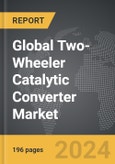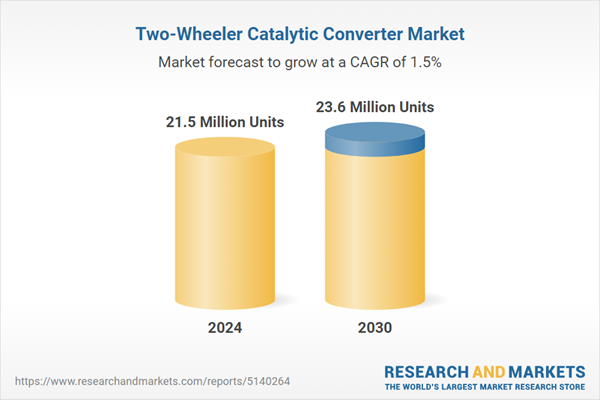The global market for Two-Wheeler Catalytic Converter was sized at 21.5 Million Units in 2024 and is projected to reach 23.6 Million Units by 2030, growing at a CAGR of 1.5% from 2024 to 2030. This comprehensive report provides an in-depth analysis of market trends, drivers, and forecasts, helping you make informed business decisions. The report includes the most recent global tariff developments and how they impact the Two-Wheeler Catalytic Converter market.
Segments: Application (Entry-Level, Mid-Size, Full-Size).
Geographic Regions/Countries: World; United States; Canada; Japan; China; Europe (France; Germany; Italy; United Kingdom; Spain; Russia; and Rest of Europe); Asia-Pacific (Australia; India; South Korea; and Rest of Asia-Pacific); Latin America (Argentina; Brazil; Mexico; and Rest of Latin America); Middle East (Iran; Israel; Saudi Arabia; United Arab Emirates; and Rest of Middle East); and Africa.
The analysts continuously track trade developments worldwide, drawing insights from leading global economists and over 200 industry and policy institutions, including think tanks, trade organizations, and national economic advisory bodies. This intelligence is integrated into forecasting models to provide timely, data-driven analysis of emerging risks and opportunities.
Global Two-Wheeler Catalytic Converter Market - Key Trends & Drivers Summarized
Why Are Two-Wheeler Catalytic Converters Essential?
Two-wheeler catalytic converters are critical components for reducing harmful emissions from motorcycles and scooters. They help convert toxic gases such as carbon monoxide, hydrocarbons, and nitrogen oxides into less harmful substances like carbon dioxide, water vapor, and nitrogen. The implementation of stringent emission regulations worldwide has made catalytic converters essential for ensuring that two-wheelers meet environmental standards. By significantly reducing the emission of pollutants, catalytic converters play a vital role in minimizing the environmental impact of two-wheelers and improving air quality, particularly in urban areas with high vehicle density.What Technological Innovations Are Shaping Catalytic Converters?
Technological advancements have led to significant improvements in the design and efficiency of two-wheeler catalytic converters. Innovations in catalyst materials, such as the use of platinum, palladium, and rhodium, enhance the conversion efficiency and durability of catalytic converters. Advances in substrate technology, including the development of high-cell density ceramic and metallic substrates, improve the surface area available for catalytic reactions, resulting in better performance and lower emissions. The integration of advanced exhaust after-treatment systems, such as oxygen sensors and electronic control units, allows for precise control of the air-fuel mixture and optimal catalytic converter operation. These technological innovations ensure compliance with increasingly stringent emission standards and improve the overall efficiency of two-wheeler catalytic converters.Why Is There an Increasing Demand Across Various Regions?
The demand for two-wheeler catalytic converters is rising across various regions due to the implementation of stringent emission regulations and the growing awareness of environmental issues. In developed regions, such as North America and Europe, strict emission standards and the increasing focus on reducing air pollution drive the demand for advanced catalytic converters. In emerging regions, such as Asia-Pacific and Latin America, rapid urbanization and the rising number of two-wheelers on the road necessitate the adoption of emission control technologies. Additionally, government initiatives aimed at promoting cleaner transportation and reducing the environmental impact of vehicles further boost the demand for catalytic converters. The growing consumer awareness of environmental sustainability also contributes to the market growth.What Are the Key Growth Drivers in the Two-Wheeler Catalytic Converter Market?
The growth in the two-wheeler catalytic converter market is driven by several factors. The implementation of stringent emission regulations worldwide is a primary driver, compelling manufacturers to equip two-wheelers with advanced catalytic converters. Technological advancements that enhance the efficiency and durability of catalytic converters contribute significantly to market growth. The increasing focus on reducing air pollution and improving air quality, particularly in urban areas, drives the demand for emission control technologies. Government initiatives and incentives aimed at promoting cleaner transportation also boost market growth. Additionally, the rising consumer awareness of environmental sustainability and the demand for eco-friendly vehicles further propel the market. The expanding two-wheeler market, particularly in emerging regions, provides significant growth opportunities for catalytic converter manufacturers.Report Scope
The report analyzes the Two-Wheeler Catalytic Converter market, presented in terms of units. The analysis covers the key segments and geographic regions outlined below.Segments: Application (Entry-Level, Mid-Size, Full-Size).
Geographic Regions/Countries: World; United States; Canada; Japan; China; Europe (France; Germany; Italy; United Kingdom; Spain; Russia; and Rest of Europe); Asia-Pacific (Australia; India; South Korea; and Rest of Asia-Pacific); Latin America (Argentina; Brazil; Mexico; and Rest of Latin America); Middle East (Iran; Israel; Saudi Arabia; United Arab Emirates; and Rest of Middle East); and Africa.
Key Insights:
- Market Growth: Understand the significant growth trajectory of the Entry-Level segment, which is expected to reach 22.4 Million Units by 2030 with a CAGR of a 1.5%. The Mid-Size segment is also set to grow at 1.2% CAGR over the analysis period.
- Regional Analysis: Gain insights into the U.S. market, sized at 5.9 Million Units in 2024, and China, forecasted to grow at an impressive 2.2% CAGR to reach 4.2 Million Units by 2030. Discover growth trends in other key regions, including Japan, Canada, Germany, and the Asia-Pacific.
Why You Should Buy This Report:
- Detailed Market Analysis: Access a thorough analysis of the Global Two-Wheeler Catalytic Converter Market, covering all major geographic regions and market segments.
- Competitive Insights: Get an overview of the competitive landscape, including the market presence of major players across different geographies.
- Future Trends and Drivers: Understand the key trends and drivers shaping the future of the Global Two-Wheeler Catalytic Converter Market.
- Actionable Insights: Benefit from actionable insights that can help you identify new revenue opportunities and make strategic business decisions.
Key Questions Answered:
- How is the Global Two-Wheeler Catalytic Converter Market expected to evolve by 2030?
- What are the main drivers and restraints affecting the market?
- Which market segments will grow the most over the forecast period?
- How will market shares for different regions and segments change by 2030?
- Who are the leading players in the market, and what are their prospects?
Report Features:
- Comprehensive Market Data: Independent analysis of annual sales and market forecasts in US$ Million from 2024 to 2030.
- In-Depth Regional Analysis: Detailed insights into key markets, including the U.S., China, Japan, Canada, Europe, Asia-Pacific, Latin America, Middle East, and Africa.
- Company Profiles: Coverage of players such as ACAT Global LLC, BASF SE, Bekaert Solaronics SA, Belrise Industries Ltd., Cambustion Ltd. and more.
- Complimentary Updates: Receive free report updates for one year to keep you informed of the latest market developments.
Some of the 46 companies featured in this Two-Wheeler Catalytic Converter market report include:
- ACAT Global LLC
- BASF SE
- Bekaert Solaronics SA
- Belrise Industries Ltd.
- Cambustion Ltd.
- Cataler Corporation
- Emitec Technologies GmbH
- Honda Motor Co., Ltd.
- Munjal Auto Industries Ltd.
- Varroc Engineering Pvt., Ltd.
Tariff Impact Analysis: Key Insights for 2025
Global tariff negotiations across 180+ countries are reshaping supply chains, costs, and competitiveness. This report reflects the latest developments as of April 2025 and incorporates forward-looking insights into the market outlook.The analysts continuously track trade developments worldwide, drawing insights from leading global economists and over 200 industry and policy institutions, including think tanks, trade organizations, and national economic advisory bodies. This intelligence is integrated into forecasting models to provide timely, data-driven analysis of emerging risks and opportunities.
What’s Included in This Edition:
- Tariff-adjusted market forecasts by region and segment
- Analysis of cost and supply chain implications by sourcing and trade exposure
- Strategic insights into geographic shifts
Buyers receive a free July 2025 update with:
- Finalized tariff impacts and new trade agreement effects
- Updated projections reflecting global sourcing and cost shifts
- Expanded country-specific coverage across the industry
Table of Contents
I. METHODOLOGYII. EXECUTIVE SUMMARY2. FOCUS ON SELECT PLAYERSIII. MARKET ANALYSISIV. COMPETITION
1. MARKET OVERVIEW
3. MARKET TRENDS & DRIVERS
4. GLOBAL MARKET PERSPECTIVE
UNITED STATES
CANADA
JAPAN
CHINA
EUROPE
FRANCE
GERMANY
ITALY
UNITED KINGDOM
SPAIN
RUSSIA
REST OF EUROPE
ASIA-PACIFIC
AUSTRALIA
INDIA
SOUTH KOREA
REST OF ASIA-PACIFIC
LATIN AMERICA
ARGENTINA
BRAZIL
MEXICO
REST OF LATIN AMERICA
MIDDLE EAST
IRAN
ISRAEL
SAUDI ARABIA
UNITED ARAB EMIRATES
REST OF MIDDLE EAST
AFRICA
Companies Mentioned (Partial List)
A selection of companies mentioned in this report includes, but is not limited to:
- ACAT Global LLC
- BASF SE
- Bekaert Solaronics SA
- Belrise Industries Ltd.
- Cambustion Ltd.
- Cataler Corporation
- Emitec Technologies GmbH
- Honda Motor Co., Ltd.
- Munjal Auto Industries Ltd.
- Varroc Engineering Pvt., Ltd.
Table Information
| Report Attribute | Details |
|---|---|
| No. of Pages | 196 |
| Published | April 2025 |
| Forecast Period | 2024 - 2030 |
| Estimated Market Value in 2024 | 21.5 Million Units |
| Forecasted Market Value by 2030 | 23.6 Million Units |
| Compound Annual Growth Rate | 1.5% |
| Regions Covered | Global |









